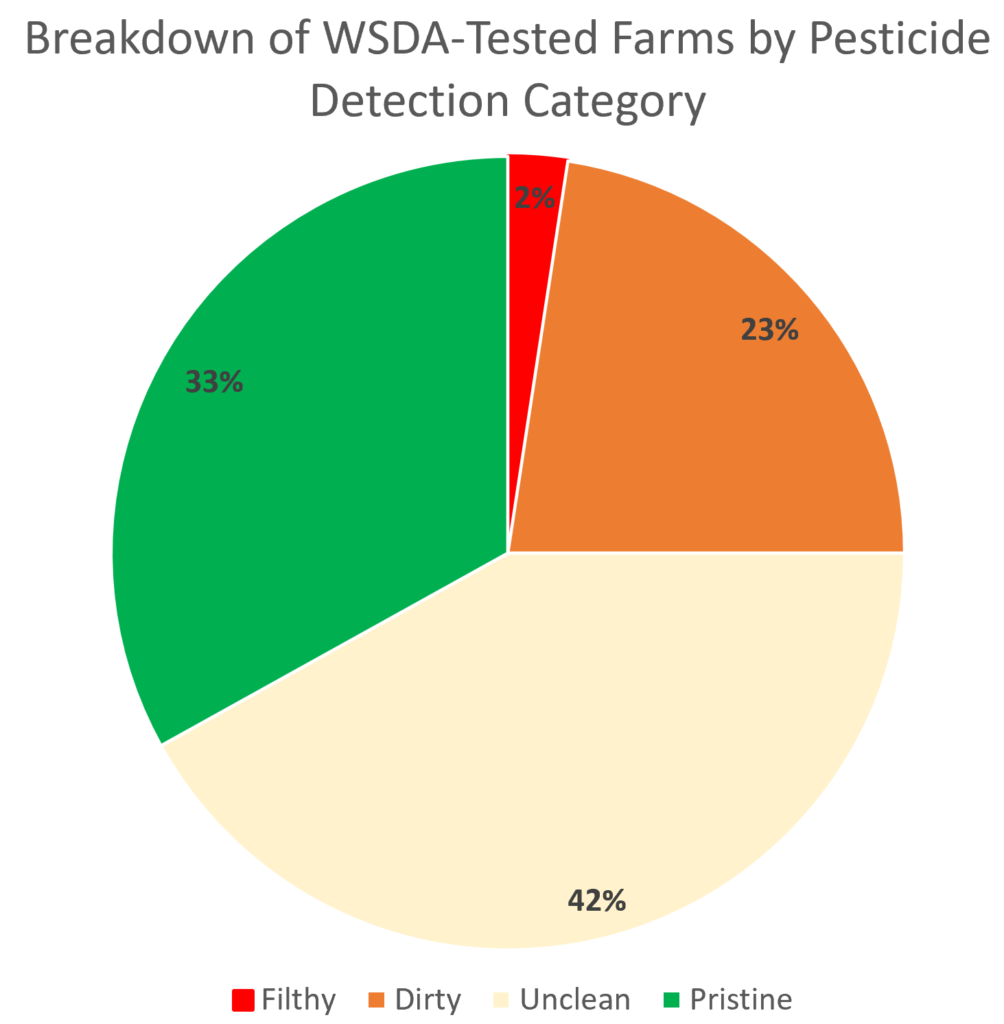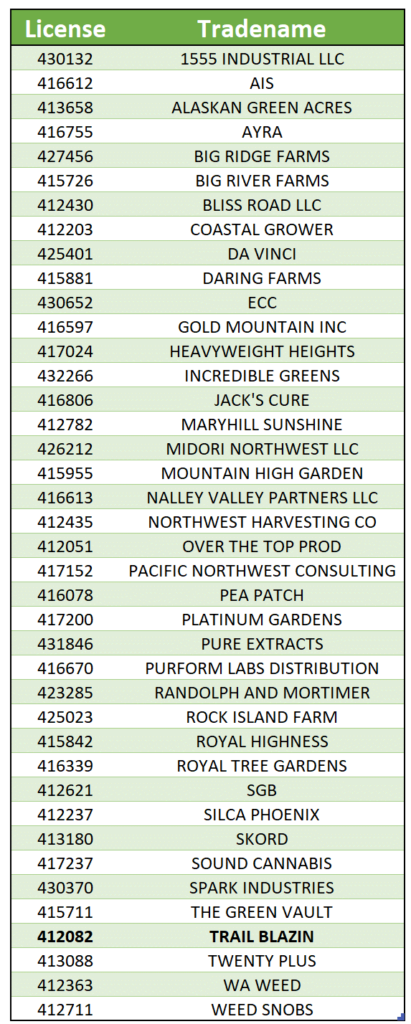
On April Fools day, 2022, the WSLCB played one of the biggest jokes ever seen on the 1,100+ growers and processors of regulated cannabis by making it the last day of the 8+ years of this market during which they were NOT required to test their product for pesticides.
While not overly funny in itself, this new requirement to actually test for pesticides potentially threw off over 8 years of R&D and process development work on how to optimally create product packaged in a way that CORCs (consumers of regulated cannabis) find attractive while maximizing revenue and, hopefully, profit. Processes that, in some cases, require the use of chemicals that kill pests or make it hard for them to reproduce or otherwise cause pest-like problems.
Between April 7, 2022 and April 7, 2023, the WSLCB sent over 600 samples of cannabis and cannabis-infused products to the WSDA Hop Lab in Yakima for testing. These samples represented product from 124 Growers and/or Processors of regulated cannabis (GORCs and PORCs, respectively), much of which was sold either to other PORCs or to Retailers of regulated cannabis (RORCs) and, ultimately , to CORCs*.
*(To be clear, that is what I BELIEVE is in the installment I received yesterday to a rather broad public records request I made last month. I’m assuming it’s everything they tested during that period because the numbers look about right for 12 months, given historic norms I’ve been able to elucidate through the WSDA data I’ve been looking at for years).
Also represented in the group were samples from two co-operative establishments used by GAPONRCs (Growers and Processors of Non-Regulated Cannabis) to ease their efforts to get their products in front of patients and other consumers interested in alternatives to highly-taxed cannabis. The results of those tests are not included here.
Overall, a handful of these 124 GORCs and PORCs had a bad time with WSDA/LCB testing and saw 100% of the products tested fail with above action-level levels of at least one pesticide (and, in some cases, quite a few pesticides). These three “filthy” operators represented (thankfully) only 2.4% of licensees whose samples were sent for analysis during that 12-month period.
Additionally, another 28 GORCs and PORCs failed with above action-level levels of at least one pesticide detected, but also had samples tested that tested pesticide-free (from among the 240-odd pesticides that the WSDA lab tests for). Together, these “dirty” operators and the three “filthy” operators above represent 25% of the licensed businesses that were tested by the WSDA lab during the year in question.
You got that right. One in four regulated cannabis businesses tested in the past year had product fail official pesticide testing. One might think that might have made the news at some point, with over 1.7 million Washingtonians regularly availing themselves of regulated cannabis offerings. There are, apparently, more important things (like who owns Twitter) to worry about, and Lord knows the LCB’s communications department is kept busy enough as it is to take on yet another consumer information project.
There I am, beginning to feel that little adrenaline rush I have come to know so well and am beginning to get upset again, so I am going to take a brief break and chill. No need to get negative. Life is too short to waste on such things. This IS about keeping CORCs safe, after all. They deserve to be kept safe, particularly since they are now generating over $1 BILLION in tax revenue for the state every biennium.
—————————————————————————————————————————
Ok. Good chill break. I just watched the first 45 minutes of the LCB Board Caucus meeting. Dr. Hoffman is going to be heading up the new Research Unit within the Agency. Good choice and good move on the part of the Agency to move in that direction. Maybe they’ll start getting things more right in the future and, by extension, less wrong. Research tends to enable that. While I’m feeling good about the WSLCB, I’ll also commend their public requests fulfillment department for getting the information that I’m covering today relating to pesticides out the door promptly. What you are about to see was provided to me (in raw form) by the group yesterday, less than three weeks after it was requested.
What was also contained in the pesticide-testing data I received yesterday (I’m feeling so glass half full right now) was a list of 41 businesses that had ZERO parts per billion detected for any and all of the 243 pesticide analytes assessed by the WSDA Yakima Hops laboratory.
For the moment, I do not want to dwell on the 3 “filthy” operators that had every tested sample fail or on the 28 “dirty” operators that had at least one of their samples fail, but also had at least one pass. I also do not want to dwell on the 52 “unclean” operators that had at least one tested sample display a non-zero detection of one or more pesticides at levels BELOW the level at which any safety-related action is deemed necessary. Nope, I’m going to ignore those 66.9% of WSDA-tested GORCs and PORCs that are making products to be consumed by Washington CORCs. That’s too negative. It’s too “glass two thirds empty” for my newer gentler kinder self.
I am also not going to dwell on the thousand or so operators that do not appear to have had samples tested by the WSDA in the past year other than to suggest that my best guess is that 2/3 of them likely look like the operators I was just discussing. That’s an admittedly naive empirical guess, but it IS empirically-based.
Instead, I’m going to dwell briefly on 40 of the 41 “pristine” GORCs and PORCs that showed not a single ppb of any of the 243 pesticides assessed in ANY of the samples that were sent to the WSDA during the year in question. I have intentionally left one GORC/PORC off of this list based on many years of having them pop out in the data I’ve spent so much time with in quite a few rather negative ways that lead me to being simply unwilling to do anything that might even mistakenly lead to business flowing in their direction.
No-one pays me to do this stuff. No-one on the list that follows has paid me for anything, ever (although I’m pretty sure I’ve had a drink bought for me by at least two owners on this list and am on friendly terms with 2-3 people associated with some of these businesses). This is an objective listing of farms that have demonstrated via testing over which they had NO control of product over which they often had FULL control that their product deserves to be thought of as “pesticide free”.
This is, sensitive and concerned consumers, a list of farms that you may reasonably view as being your best bets right now of purchasing product free from pesticides in this state’s regulated cannabis market. They are not the only ones — but they are the only ones I currently have data on that allows me to make this statement.
I highlighted Trail Blazin’ because they are one of the only GORC/PORCs that has embraced the notion of putting their money where their hearts lie by conducting both pesticide and heavy metals testing of ALL of their products and jumping through the hoops necessary to get DOH-level “Medical-Grade” certifications since that program began in 2016. Like Washington Bud Company (who was not tested by the WSDA/LCB joint venture in the last year, so had no chance to make the list), I fully EXPECT their product to be clean.
We KNOW it to be clean for the 53 pesticides that the LCB requires, and it is gratifying to see that it is also clean for the 190 pesticides that the WSDA includes in it’s testing panel. We also know it to be clean of heavy metals (specifically, lead, inorganic arsenic, cadmium and mercury) — something that is not the case at all outside of DOH-certified medical grade cannabis products in this state.
To the extent that this sample of 124 businesses generalizes well to the 1000+ that have NOT been tested by WSDA in the past year, about 2/3 of those businesses are (on average) likely to have product that would not be as pristine as is, seemingly, the product produced by the businesses listed below.
I feel good. Enhancing consumer protection makes me feel good. I’ve been missing it here in Washington (consumer protection, that is … not feeling good. I feel good quite a bit.)
Stay tuned to HI-Blog over the next few weeks. I’m going to be publishing quite a bit that should have relevance to anyone concerned about the “safety” and “quality” of regulated cannabis in Washington and wondering if one of their friends or acquaintances in the GAPONRC movement might not be a better source for their cannabis than the taxed alternatives.
All I can suggest to those concerned about what they put in their bodies when they look at this list is:
Put that in your pipe and smoke it!
I sincerely hope that you find this useful — even if the glass is only 1/3 full, at least it’s not empty!

Jim,
Thank you for this! I think this might be the first list of any kind for my young business and it’s a great one to be on! I am the owner/operator and main grower for Bliss Road llc. I sell under the brand Honeydew and have only been doing retail about a year. We are currently looking for a few more retailers if there are any buyers out there looking for clean cannabis please feel free to reach out.
best regards,
Nick
IG: @honeydewthc
email: Nick@blissroadthc.com
It is, indeed, a great list to be on.
Congratulations for that.
A quick reminder to all that, during the period in question, over 800 farms WERE NOT TESTED by the WSDA/LCB Joint Venture in consumer protection.
It is quite likely that, had THEY all been tested, that quite a few would have also made the list (a bit shy of 200 is my best estimate).
Then again, about 700 would have failed to.
Again … congratulations.
Thanks, Jim, for being willing to look at data and interpret it for the rest of us.
My pleasure, Shawn.
I felt it appropriate to name your company in the text accompanying the list because Washington Bud Co.’s years-long history of testing to DOH standards for medical cannabis and consistently testing clean for not only the I-502 panel of pesticides, but ALSO the full suite of required Heavy Metals tests led to that decision. When I saw Trailblazin’s name pop up in the dataset, I was not at all surprised that they tested “Pristine”. Regularly testing your product to DOH “medical grade” standards gives a farm a big leg up in the chances of success.
I have no doubt, given your history of consistently passing tests for both heavy metals and pesticides for all of the product you produced that you would have been on the “Pristine” list, had you been tested.
That should serve as a reminder to readers that there are many farms in operation (hundreds) that were not tested by the WSDA lab during the last year and, hence, had zero chance of showing up on the Pristine list. They were not in the datafile because they were not tested. I suspect that a wider swath of the pesticide testing data that the WSDA/LCB have been producing for the past 6+ years will soon be available in a form where a more comprehensive listing of “Pristine” operators can be derived.
There are likely to be more. When I identify them, I’ll share.